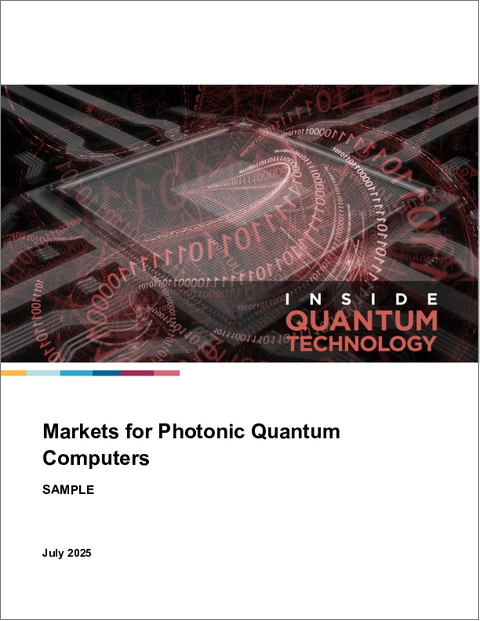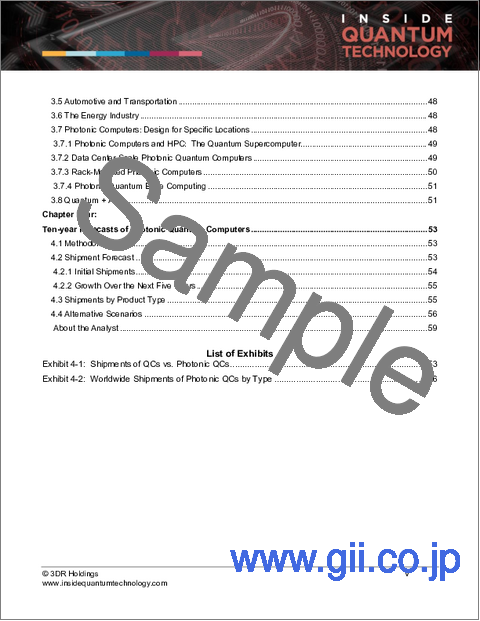|
|
市場調査レポート
商品コード
1767025
フォトニック量子コンピュータ市場Markets for Photonic Quantum Computers |
||||||
|
|||||||
| フォトニック量子コンピュータ市場 |
|
出版日: 2025年07月07日
発行: Inside Quantum Technology
ページ情報: 英文 58 Pages
納期: 即納可能
|
全表示
- 概要
- 目次
フォトニック量子コンピュータは、(1)室温での計算が可能であり、(2)通信業界向けの既製品の光ネットワークコンポーネントを用いて低コストで構築可能であるという信念に後押しされ、実行可能な量子コンピューティングプラットフォームとして急速に台頭しつつあります。当レポートの主な目的は、フォトニクスを主要ファブリックに用いた量子コンピュータの商業的可能性を分析・定量化し、その売上を予測することです。2030年までに世界のフォトニクス量子コンピュータの市場規模は11億米ドルに達し、2035年には68億米ドル以上に成長すると予測されています。供給側では、新たな企業がフォトニックコンピュータ市場に参入します。需要側では、量子コンピューター全体の需要が劇的に増加し、この高い成長はフォトニックQCに影響を与えると思われます。
現在、フルスタックのフォトニック量子コンピュータを商業化しているベンダーはすでに20社ほどあり、中でもPsiQuantumはこれまでに最大の資金を集め、Xanaduも大きな注目を集めています。当レポートでは、Beijing Bose Quantum, Technology、Mitre Corporation、NTT、ORCA、Photonic、Quickly Quantum、PsiQuantum、Q.Ant、QC82、Quandela、Quanfluence、Quantum Computing, Inc、Quantum Source Labs、QuiXQuantum、Rotonium、Tundra Systems、Turing、Xanadu Quantum Technologiesなど、フルスタックフォトニックコンピュータの全メーカーの製品/市場戦略を分析しています。
当レポートでは、萌芽的なフォトニック量子システム分野に関連するコンポーネント、PIC、ソフトウェアのサプライヤーを紹介するとともに、フォトニックコンピューター市場の10年予測も掲載しています。予測は、「ユーティリティクラス」、「HPC/エンタープライズ」、「その他」の3つのタイプに分け、台数ベースと金額ベースの両方で提供しています。また、フォトニック量子コンピュータのアプリケーションに関する章も設け、フォトニックコンピュータが特に好まれる分野についても言及しています。
目次
第1章 フォトニック量子コンピュータ:製品と業界の背景
- 報告書の背景
- フォトニック量子コンピュータの利点
- フォトニック量子コンピュータの課題
- フォトニック量子コンピュータの種類
- フォトニック量子コンピュータ向けチップとチップセット
- 研究機関および大学
- 商業サプライヤー
- コンポーネントとサブシステム
- レーザーと光源
- 周波数コム
- 光子検出器
- コントロールチップ
- SDK
- フォトニック量子コンピュータ(QC)の新しいアーキテクチャ
- CVアーキテクチャ
- Tセンターのアーキテクチャ
- バリューQCブランドコミュニティ:フォトニックQCへの適用性
- Quandela Cloud
- Xanadu
- フォトニック量子コンピュータ産業構造
- ロシアと中国
- 新たなチャプター
第2章 フォトニック量子コンピュータと関連製品
- Bose Quantum Technology/QBoson(中国)
- 現在の製品
- 顧客基盤と市場
- Electronics and Telecommunications Research Institute(ETRI)(韓国)
- InfamousPlatypus(米国)
- 顧客基盤と競合
- MITRE Corporation/CVE(米国)
- 量子ムーンショット
- 顧客基盤
- NTT(日本)
- 現在の調査
- ORCA Computing(英国)
- PTシリーズ製品
- COTSの使用
- ORCAのお客様:HPCでの使用
- Photonic(カナダ)
- 製品と技術の進化
- 顧客基盤と競合
- PsiQuantum(米国)
- 技術の進化
- 顧客基盤と競合
- Q.Ant(ドイツ)
- QC82(米国)
- 会社の目標
- 想定される顧客基盤
- Quandela
- テクノロジーと製造
- クアンデラクラウド
- 顧客基盤と競合
- Quanfluence(インド)
- Quantum Computing, Inc.(米国)
- 現在の製品とサービス
- 顧客基盤と競合
- Quantum Source Labs(イスラエル)
- コンピュータ戦略
- 顧客基盤
- QuiX Quantum(オランダ)
- 現在の製品
- 顧客
- Rotonium(イタリア)
- 調査と製品開発の方向性
- 製造業
- 潜在的な顧客基盤
- Spooky Manufacturing(米国)
- TundraSystems Global LTD(英国)
- TuringQ(中国)
- 量子コンピュータの提供と製造
- 顧客基盤
- Xanadu Quantum Technologies(カナダ)
- 製品とテクノロジー
- 製造業
- 顧客とパートナー
- Xanadu Cloudクラウドの興亡
- コンポーネント
- ID Quantique(スイス)
- M-Labs(中国)
- Menlo Systems(ドイツ)
- Nanofiber Quantum Technologies(日本)
- Nexus Photonics(米国)
- Nicslab(米国)
- Sparrow Quantum(デンマーク)
- Toptica Photonics(ドイツ)
- Toshiba(日本)
- Vescent(米国)
- サービス
- Iceberg Quantum(オーストラリア)
- ソフトウェア
- QC Design(ドイツ)
- QMware(スイス)
- プラットフォーム
- qBraid(米国)
- 研究機関と大学
- Centre for Quantum Computation and Communication Technology(CQC2T)(オーストラリア)
- Griffith University(オーストラリア)
- Harvard University(米国)
- Institute for Photonic Quantum Systems(PhoQC)(ドイツ)
- Israeli Quantum Computing Center (IQCC)(イスラエル)
- Nanjing University(中国)
- National Quantum Computing Center(NQCC)(英国)
- National Quantum Laboratory(NQL)(ロシア)
- Niels Bohr Institute(NBI)(デンマーク)
- Poznan Supercomputing and Networking Center ((PSNC)
- Queensland University of Technology(QUT)(オーストラリア)
- RIKEN(日本)
- Russian Quantum Center(ロシア)
- Sandia National Laboratory (米国)
- Simon Fraser University(カナダ)
- University of Arizona(米国)
- University of Bristol (英国)
- University of New Mexico(米国)
- University of Queensland(オーストラリア)
- University of Science & Technology of China(USTC)
- University of Southern Queensland (UniSQ)(オーストラリア)
- University of the Sunshine Coast(オーストラリア)
- University of Virginia(UVA)(米国)
- University of Washington(UW)(米国)
- University of Waterloo(カナダ)
第3章 フォトニック量子コンピュータの標的用途
- 研究機器と研究室
- 量子化学と材料科学
- 金融と銀行
- 軍事、諜報、航空宇宙
- 自動車・輸送
- エネルギー業界
- フォトニックコンピュータ:特定の場所向けの設計
- フォトニックコンピュータとHPC:量子スーパーコンピュータ
- データセンター規模のフォトニック量子コンピュータ
- ラックマウント型フォトニックコンピュータ
- 光量子エッジコンピューティング
- 量子+AI
第4章 フォトニック量子コンピュータの10年予測
- 調査手法
- 出荷予測
- 初期出荷
- 今後5年間の成長
- 製品タイプ別出荷
- 代替シナリオ
- アナリストについて
Photonic Quantum Computers are quickly emerging as a viable quantum computing platform driven by the belief that they can (1) compute at room temperatures and (2) can be built at low cost using off-the-shelf optical networking components intended for the telecom industry. Our primary goal in this report is to analyze and quantify the commercial potential of quantum computers using photonics for their main fabric and to forecast their sales. We show how by 2030, worldwide revenues from photonic quantum computers will have reached US$1.1 billions shipped but this number will grow to more than US$6.8 billions by 2035. On the supply side new firms will be entering the photonic computer market. On the demand side, the demand for quantum computers as a whole will increase dramatically, and this high growth will impact photonic QCs.
There are already around 20 vendors commercializing full stack photonic quantum at the present time with PsiQuantum having attracted the largest funding to date and Xanadu attracting considerable attention too. This report, analyzes the product/market strategies of all the manufacturers of full-stack photonic computers including Beijing Bose Quantum, Technology, Mitre Corporation, NTT, ORCA, Photonic, Quickly Quantum, PsiQuantum, Q.Ant,QC82, Quandela, Quanfluence, Quantum Computing, Inc., Quantum Source Labs, QuiXQuantum, Rotonium, Tundra Systems, Turing and Xanadu Quantum Technologies.
In this report we also profile the relevant component, PIC and software suppliers to the budding photonic quantum systems sector as well as including ten-year forecasts of photonic computer markets. The forecasts are broken out by three types of machines "Utility-Class," "HPC/enterprise" machines and "Other" forecasts are provided in both volume and value terms. We also include a Chapter on applications for photonic quantum computers, noting where photonic where photonic machines are especially favored.
Table of Contents
Chapter One: Photonic Quantum Computers: Products and Industry Background
- 1.1. Background to Report
- 1.2. Advantages of Photonic Quantum Computers
- 1.3. Challenges of Photonic Quantum Computers
- 1.4. Types of Photonic Quantum Computers
- 1.5. Chips and Chipsets for Photonic Quantum Computers
- 1.5.1. Research Institutes and Universities
- 1.5.2. Commercial Suppliers
- 1.6. Components and Subsystems
- 1.6.1. Lasers and Light Sources
- 1.6.2. Frequency Combs
- 1.6.3. Photon Detectors
- 1.6.4. Control Chips
- 1.6.5. SDKs
- 1.7. Novel Architectures for Photonic QCs
- 1.7.1. CV Architectures
- 1.7.2. T Centre architecture
- 1.8. The Value QC Brand Communities: Applicability to Photonic QCs
- 1.8.1. Quandela Cloud
- 1.8.2. Xanadu
- 1.9. Photonic Quantum Computer Industry Structure
- 1.9.1. Russia and China
- 1.10. The Next Chapter
Chapter Two: Photonic Quantum Computers and Related Products
- 2.1. Bose Quantum Technology/QBoson (China)
- 2.1.1. Current Products
- 2.1.2. Customer Base and Markets
- 2.2. Electronics and Telecommunications Research Institute (ETRI) (Korea)
- 2.3. InfamousPlatypus (United States)
- 2.3.1. Customer Base and Competition
- 2.4. MITRE Corporation/CVE (United States)
- 2.4.1. Quantum Moonshot
- 2.4.2. Customer Base
- 2.5. NTT (Japan)
- 2.5.1. Current Research
- 2.6. ORCA Computing (United Kingdom)
- 2.6.1. PT Series Products
- 2.6.2. Use of COTS
- 2.6.3. ORCA Customers: Use with HPC
- 2.7. Photonic (Canada)
- 2.7.1. Product and Technology Evolution
- 2.7.2. Customer Base and Competition
- 2.8. PsiQuantum (United States)
- 2.8.1. Technical Evolution
- 2.8.2. Customer Base and Competition
- 2.9. Q.Ant (Germany)
- 2.10. QC82 (United States)
- 2.10.1. Goals of Company
- 2.10.2. Expected Customer Base
- 2.11. Quandela
- 2.11.1. Technology and Manufacturing
- 2.11.2. Quandela Cloud
- 2.11.3. Customer Base and Competition
- 2.12. Quanfluence (India)
- 2.13. Quantum Computing, Inc. United States)
- 2.13.1. Current Products and Services
- 2.13.2. Customer Base and Competition
- 2.14. Quantum Source Labs (Israel)
- 2.14.1. Computer Strategy
- 2.14.2. Customer Base
- 2.15. QuiX Quantum (The Netherlands)
- 2.15.1. Current Products
- 2.15.2. Customers
- 2.16. Rotonium (Italy)
- 2.16.1. Direction of Research and Product Development
- 2.16.2. Manufacturing
- 2.16.3. Possible Customer Base
- 2.17. Spooky Manufacturing (United States)
- 2.18. TundraSystems Global LTD (United Kingdom)
- 2.19. TuringQ (China)
- 2.19.1. Quantum Computer Offerings and Manufacturing
- 2.19.2. Customer Base
- 2.20. Xanadu Quantum Technologies (Canada)
- 2.20.1. Products and Technology
- 2.20.2. Manufacturing
- 2.20.3. Customers and Partners
- 2.20.4. The Rise and Fall of Xanadu Cloud
- 2.21. Components
- 2.21.1. ID Quantique (Switzerland)
- 2.21.2. M-Labs (China)
- 2.21.3. Menlo Systems (Germany)
- 2.21.4. Nanofiber Quantum Technologies (Japan)
- 2.21.5. Nexus Photonics (United States)
- 2.21.6. Nicslab (United States)
- 2.21.7. Sparrow Quantum (Denmark)
- 2.21.8. Toptica Photonics (Germany)
- 2.21.9. Toshiba (Japan)
- 2.21.10. Vescent (United States)
- 2.22. Services
- 2.22.1. Iceberg Quantum (Australia)
- 2.23. Software
- 2.23.1. QC Design (Germany)
- 2.23.2. QMware (Switzerland)
- 2.24. Platforms
- 2.24.1. qBraid (United States)
- 2.25. Research and Universities
- 2.25.1. Centre for Quantum Computation and Communication Technology (CQC2T) (Australia)
- 2.25.2. Griffith University (Australia)
- 2.25.3. Harvard University ( United States)
- 2.25.4. Institute for Photonic Quantum Systems (PhoQC) (Germany)
- 2.25.5. Israeli Quantum Computing Center (IQCC) (Israel)
- 2.25.6. Nanjing University (China)
- 2.25.7. National Quantum Computing Center (NQCC) (United Kingdom)
- 2.25.8. National Quantum Laboratory (NQL) (Russia)
- 2.25.9. Niels Bohr Institute (NBI) (Denmark)
- 2.25.10. Poznan Supercomputing and Networking Center (PSNC)
- 2.25.11. Queensland University of Technology (QUT) (Australia)
- 2.25.12. RIKEN (Japan)
- 2.25.13. Russian Quantum Center (Russia)
- 2.25.14. Sandia National Laboratory (United States)
- 2.25.15. Simon Fraser University (Canada)
- 2.25.16. University of Arizona (United States)
- 2.25.17. University of Bristol (United Kingdom)
- 2.25.18. University of New Mexico (United States)
- 2.25.19. University of Queensland (Australia)
- 2.25.20. University of Science & Technology of China (USTC)
- 2.25.21. University of Southern Queensland (UniSQ) (Australia)
- 2.25.22. University of the Sunshine Coast (Australia)
- 2.25.23. University of Virginia (UVA) (United States)
- 2.25.24. University of Washington (UW) (United States)
- 2.25.25. University of Waterloo (Canada)
Chapter Three: Target Applications for Photonic Quantum Computers
- 3.1. Research Machines and Laboratories
- 3.2. Quantum Chemistry and Materials Science
- 3.3. Finance and Banking
- 3.4. Military, Intelligence and Aerospace
- 3.5. Automotive and Transportation
- 3.6. The Energy Industry
- 3.7. Photonic Computers: Design for Specific Locations
- 3.7.1. Photonic Computers and HPC: The Quantum Supercomputer
- 3.7.2. Data Center Scale Photonic Quantum Computers
- 3.7.3. Rack-Mounted Photonic Computers
- 3.7.4. Photonic Quantum Edge Computing
- 3.8. Quantum + AI
Chapter Four: Ten-year Forecasts of Photonic Quantum Computers
- 4.1. Methodology
- 4.2. Shipment Forecast
- 4.2.1. Initial Shipments
- 4.2.2. Growth Over the Next Five Years
- 4.3. Shipments by Product Type
- 4.4. Alternative Scenarios
- About the Analyst
List of Exhibits
- Exhibit 4-1: Shipments of QCs vs. Photonic QCs
- Exhibit 4-2: Worldwide Shipments of Photonic QCs by Type





